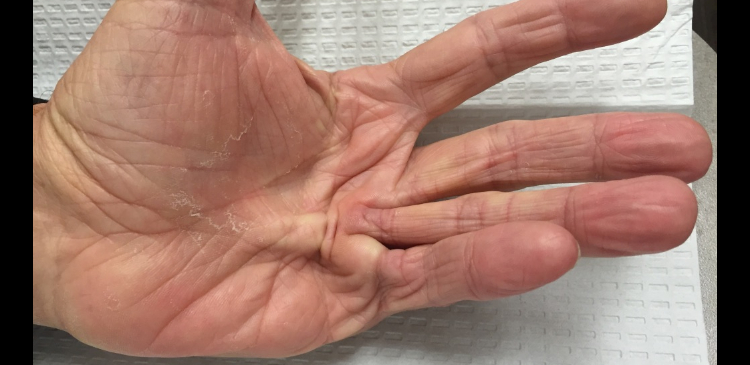Dupuytren's contracture
Diagnosis
In most cases, doctors can diagnose Dupuytren's contracture by the look and feel of your hands. Other tests are rarely necessary.
Your doctor will compare your hands to each other and check for puckering on the skin of your palms. He or she will also press on parts of your hands and fingers to check for toughened knots or bands of tissue.
Your doctor also might check to see if you can put your hand flat on a tabletop or other flat surface. Not being able to fully flatten your fingers indicates you have Dupuytren's contracture.
Treatment
If the disease progresses slowly, causes no pain and has little impact on your ability to use your hands for everyday tasks, you might not need treatment. Instead, you can wait and see if Dupuytren's contracture progresses. You may wish to follow the progression with a tabletop test, which you can do on your own.
Treatment involves removing or breaking apart the cords that are pulling your fingers toward your palm. This can be done in several ways. The choice of procedure depends on the severity of your symptoms and other health problems you may have.
Needling
This technique uses a needle, inserted through your skin, to puncture and break the cord of tissue that's contracting a finger. Contractures often recur but the procedure can be repeated.
The main advantages of the needling technique are that there is no incision, it can be done on several fingers at the same time, and usually very little physical therapy is needed afterward. The main disadvantage is that it can't be used in some places in the finger because it could damage a nerve or tendon.
Enzyme injections
Injecting a type of enzyme into the taut cord in your palm can soften and weaken it — allowing your doctor to later manipulate your hand in an attempt to break the cord and straighten your fingers. The FDA has approved collagenase Clostridium histolyticum (Xiaflex) for this purpose. The advantages and disadvantages of the enzyme injection are similar to needling. Enzyme injections are not offered at all medical institutions.
Surgery
Another option for people with advanced disease, limited function and progressing disease is to surgically remove the tissue in your palm affected by the disease. The main advantage to surgery is that it results in a more complete and longer-lasting release than that provided by the needle or enzyme methods. The main disadvantages are that physical therapy is usually needed after surgery, and recovery can take longer.
In some severe cases, especially if surgery has failed to correct the problem, surgeons remove all the tissue likely to be affected by Dupuytren's contracture, including the attached skin. In these cases a skin graft is needed to cover the open wound. This surgery is the most invasive option and has the longest recovery time. People usually require months of intensive physical therapy afterward.
Lifestyle and home remedies
If you have mild Dupuytren's contracture, you can protect your hands by:
- Avoiding a tight grip on tools by building up the handles with pipe insulation or cushion tape
- Using gloves with heavy padding during heavy grasping tasks
However, your condition may persist or worsen, despite these precautions.
Preparing for your appointment
While you might first bring your symptoms to the attention of your family doctor, he or she might refer you to an orthopedic surgeon.
What you can do
Before your appointment, you might want to write a list that answers the following questions:
- Do you have a family history of this problem?
- What treatments have you tried? Did they help?
- What medications and supplements do you take regularly?
for symptoms and causes , click here

